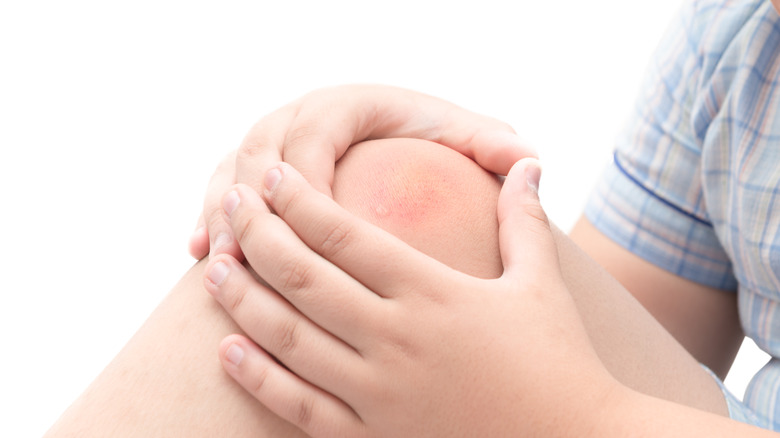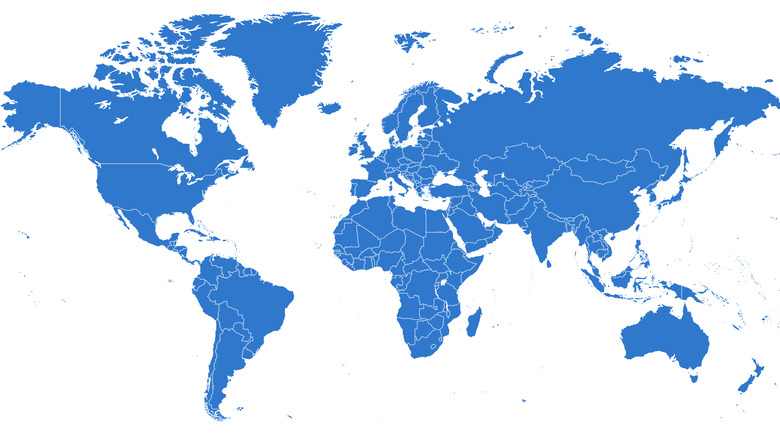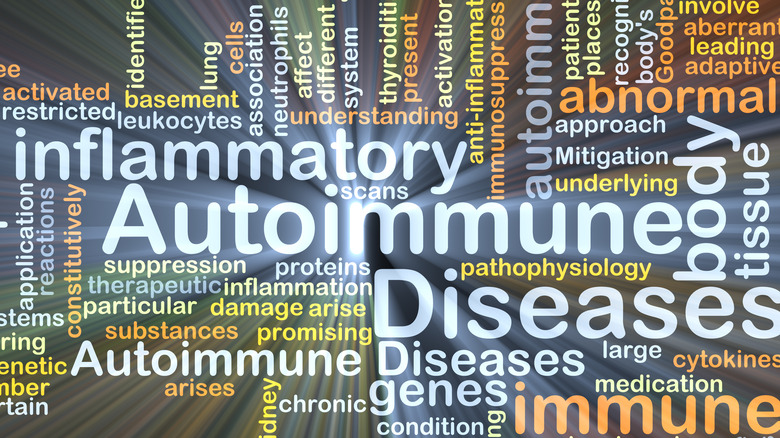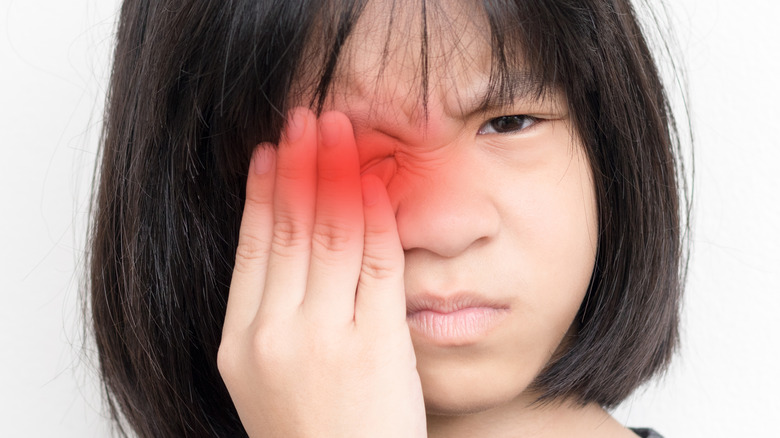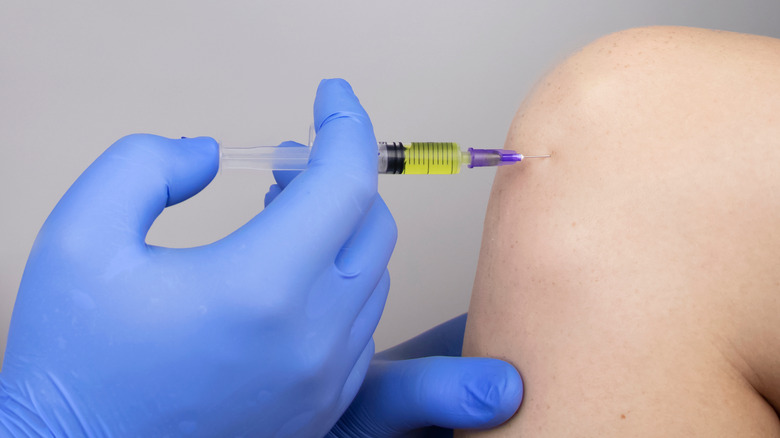Juvenile Idiopathic Arthritis: Causes, Symptoms, And Treatments
Juvenile idiopathic arthritis (JIA) is a form of arthritis that occurs in children up to 16 years of age and persists for more than six weeks, reports WebMD. JIA is characterized by joint inflammation that causes stiffness, swelling, redness, warmth, and soreness. While the disease can attack any joint and even lead to loss of motion of the joint, many children with JIA do not have symptoms.
As explained by the Arthritis Foundation, JIA was formerly known as juvenile rheumatoid arthritis. However, the name changed because JIA is distinct from adult rheumatoid arthritis in that it represents several different types of joint conditions. It is the most common form of arthritis in children. While the cause of JIA has not been determined (hence the term "idiopathic"), it is known that JIA is an inflammatory autoimmune condition. In autoimmune disorders, the body's immune system malfunctions by mistakenly attacking and damaging the body's healthy cells and tissues rather than foreign invaders such a bacteria or viruses. In the case of JIA, immune cells target the synovial tissue that protects joints and keeps them well lubricated for ease of movement. Damaged synovial tissue can cause pain, swelling, and impaired mobility.
Some types of JIA can lead to complications such as joint damage, slow growth, and vision problems, notes the Cleveland Clinic. Treatment primarily involves medications and exercise and aims to strengthen and improve functioning of joints, reduce pain and swelling, and avoid joint damage and complications. Read on to learn more.
Types of JIA
Several types of JIA exist. The most prevalent and mildest form of JIA affecting around 50% of children with the condition is oligoarticular JIA (via the National Institute of Arthritis and Musculoskeletal and Skin Diseases (NIAMS). Oligoarticular JIA involves only one to four joints, usually the knees or ankles, within the first six months after diagnosis. Symptoms may continue for more than six months without involving additional joints (persistent) or involving five or more joints (extended). This type of JIA can cause chronic uveitis (eye inflammation) in some children. In direct contrast to oligoarticular JIA, polyarticular JIA affects five or more joints during the initial six months of the disease. Blood tests may show a positive rheumatoid factor. In these cases, more often seen in pre-teen and teenage girls, the disease is no different than adult autoimmune rheumatoid arthritis.
Enthesitis-related JIA is a form of JIA characterized by inflamed tissue where the bone attaches to a tendon or ligament (enthesitis). It is more common in boys, usually involving the knees, heels, and feet. Children with psoriatic JIA, another type, suffer from the skin disease psoriasis as well as arthritis. While typically the psoriasis (marked by pitted fingernails and swelling in the fingers or toes) develops before the arthritis, the inverse can occur as well. Per Johns Hopkins, systemic JIA extends beyond the joints and inflames internal organs such as the heart, liver, spleen, and lymph nodes. Undifferentiated JIA features symptoms that parallel two or more other types, or none.
Prevalence of JIA
There are an estimated 3 million children and young adults living with JIA worldwide (via a 2021 study in Pediatric Rheumatology Online Journal). The prevalence of JIA is higher in girls than boys, though; per Medscape, boys are afflicted with enthesitis-related JIA more often than girls. With regard to age, JIA has the highest prevalence among children aged 1 to 3.
Oligoarticular JIA dominates among the subtypes, occurring in 50% to 60% of JIA cases (per StatPearls). Polyarticular JIA-rheumatoid factor negative is the second most common form of JIA, coming in at 11% to 28%. The least common form of JIA is enthesitis-related JIA, with a prevalence of only 1% to 7%.
Certain autoimmune disorders occur more frequently in parents of children with JIA than in the general population, per a study in a 2022 edition of Pediatric Rheumatology Online Journal. A family history of autoimmune disease was found to be more prevalent in JIA children living in industrialized countries compared to developing nations.
Causes of JIA
While the exact cause of JIA has not been determined, it appears to involve a mix of genes and environmental factors interacting to cause autoimmunity, whereby the immune system malfunctions and attacks the synovium, the soft tissue lining the inner surface of a joint (per the Cleveland Clinic).
While potential environmental triggers of autoimmunity include antibiotic exposure and C-section deliveries, other factors such as breastfeeding and siblings living together without the parents are associated with a lower risk of autoimmunity (via StatPearls). Other potential triggers of JIA include various microbes such as Epstein-Barr virus, enteric bacteria, and Streptococcus. Multiple genes associated with both JIA and other autoimmune conditions play a central role in the development of JIA by making a child genetically predisposed to the disease (per Medscape).
As reported by the National Institute of Arthritis and Musculoskeletal and Skin Diseases, the joint inflammation associated with some types of JIA is driven, at least in part, by three molecules: TNF-alpha, IL-6, and IL-1. Treatments for JIA include drugs that inhibit these inflammatory molecules.
Risk factors for JIA
JIA can strike any child regardless of race or ethnicity, notes the National Institute of Arthritis and Musculoskeletal and Skin Diseases. To some extent, a family history of arthritis increases the risk of JIA; in particular, a family history of psoriasis is associated with a higher risk of psoriatic JIA.
A 2018 study published in The Journal of Rheumatology investigated exposure to outdoor and indoor pollution during pregnancy and after birth until the onset of JIA. Potential risk factors identified include exposure to cigarette smoke during pregnancy and after birth, exposure to air pollutants during the second year of life, and exposure of working mothers to pollutants such as volatile vapors from paints or gasoline. Notably, nicotine and tar, along with around 9,600 other chemicals in tobacco, may be transferred to the fetus when mothers smoke during pregnancy. Exposure to cigarette smoke in utero is also linked to changes in DNA methylation which can adversely affect the expression of genes in the child.
Children with allergic diseases such as asthma and allergic rhinitis are also at greater risk of developing JIA, via a study in Pediatric Rheumatology Online Journal. According to one potential mechanism, allergic diseases and JIA may share common genes that impair immune function, causing immune cells to either overreact (allergies) or attack healthy tissue (autoimmune JIA). An alternative explanation suggests that antigens (substances that trigger an immune response) present in foods may activate the immune system in both conditions.
Signs and symptoms of JIA
Symptoms of JIA are more prominent during disease flare-ups but subside at other times, reports the Mayo Clinic. While symptoms vary, pain and swelling are among the most frequently occurring symptoms of JIA.
Some children do not suffer from any joint pain, but may develop a noticeable limp. Swelling is common and more detectable in the knee joint and other large joints. A child stumbling about in the morning or after napping may be a sign of joint stiffness. Another child may not eat enough food due to reduce appetite, which can lead to slow growth and inadequate weight gain (via Johns Hopkins). Other children may experience warmth and redness and even limited movement in a joint. In cases of systemic JIA, a child may develop a high fever, swollen lymph nodes, or a rash.
Children with any type of JIA may appear tired and cranky, notes the Cleveland Clinic. According to Medical News Today, many children with JIA develop severe eye problems. Eyes can become inflamed and red, which can persist long-term. Children with oligoarticular JIA are the most prone to eye inflammation.
Diagnosis of JIA
The diagnosis and classification of JIA requires a complete health history and physical exam that focuses on the musculoskeletal system (via StatPearls). The history should document the child's symptoms and when they began, the specific joints affected, and any associated diseases the child may also have. A diagnosis of JIA is suspected If a child under the age of 16 has arthritis for a minimum of six weeks.
While a diagnosis of JIA cannot be made with one specific test, several blood tests may be used to help rule out other conditions (per Johns Hopkins). These include tests for antinuclear antibodies (ANA) and rheumatoid factor, both associated with rheumatoid arthritis and other rheumatic diseases. Elevated sed rate (erythrocyte sedimentation rate) and CRP (C-reactive protein) indicate inflammation, while a low complement (proteins in the blood that protect against infections) suggests abnormal immune function. Other blood tests that may be included in the diagnostic workup include a complete blood count (CBC), creatinine, hematocrit (low numbers of red blood cells are linked to arthritis), and white blood cell count. Apart from blood tests, urine tests (to assess kidney function), joint aspiration (synovial fluid is analyzed for crystals and microbes), and a complete eye exam may be performed.
Imaging scans such as X-rays and magnetic resonance imaging (MRI) can contribute to the diagnosis process by helping to detect any joint damage or broken bones (via the Mayo Clinic). These scans can also identify tumors, infections, and birth defects.
Treatment of JIA
According to the American College of Rheumatology (ACR), a medical team consisting of a pediatric rheumatologist, a physical and occupational therapist, social worker, and nurse specialist is ideally suited to treat children with JIA. In general, treatment goals include symptom management, prevention of joint damage, and preservation of joint mobility. Anti-inflammatory steroids can be given locally by injection into a joint when the disease only affects a few joints. Alternatively, short-term use of low doses of prednisone or other oral steroid medications may be indicated for some children. Extended use of oral steroids can cause serious adverse effects such as delayed growth, cataracts, high blood pressure, infections, osteoporosis, and increased susceptibility to infections.
For children who have a form of JIA that affects multiple joints or is resistant to steroid injections, more potent medications known as DMARDs (disease-modifying antirheumatic drugs) may be necessary. DMARDs such as methotrexate work by suppressing the immune attack against joints, notes Healthline. Biologics are another class of drugs that are used to treat JIA. These dugs quell inflammation and prevent joint damage and include rituximab (Rituxan) and TNF inhibitors (Humira). In addition to medications, adds Johns Hopkins, physical and occupational therapy may improve joint mobility and daily functioning, respectively. Lifestyle changes (e.g., healthier diet, regular exercise, restful sleep, and weight management) may benefit children with JIA as well.
Complications of JIA
About 10% of children with systemic JIA develop a life-threatening complication called macrophage activation syndrome (MAS), via the Arthritis Foundation. In MAS, overreaction of the immune system, often to infections, results in a flood of inflammatory chemicals throughout the body. Excessive inflammation can damage the heart, liver, spleen, kidneys, and other organs. A speedy diagnosis is critical since MAS can occur suddenly. Lethargy, confusion, poor appetite, and inattentiveness are signs that a child may have MAS.
Leg-length discrepancy and joint contracture are among the potential complications of JIA (via MSD Manual). Leg-length discrepancy occurs when one leg is shorter than the other (via Boston Children's Hospital). This can lead to posture problems (e.g., tilted shoulders) or changes in gait (e.g., limping). Some children with this condition may have problems with their knees or ankles or complain of back or hip pain. As described by Healthline, joint contractures occur when the fibrous tissue surrounding a joint loses flexibility and becomes more rigid, thus restricting mobility of the joint.
Severe cases of JIA can cause delayed growth and significant erosion and deterioration of joints, notes MedlinePlus. Some affected children may suffer from chronic pain and avoid attending school. Other serious complications of JIA include vision loss, anemia, and swelling of the pericardium, the lining around the heart.
Diet/supplements for JIA
According to the Arthritis Foundation, an anti-inflammatory diet can benefit people who have arthritis at any age. Children with JIA should stay clear of highly processed foods loaded with sugar and unhealthful fats. These junk foods can inflame joints and may worsen JIA. Chips, fast food, sugary snacks and cereals, fries, donuts, cookies, and pastries are high on the list of pro-inflammatory foods. Parents should check food labels for unhealthful ingredients such as trans fats, partially hydrogenated oils, and high fructose corn syrup. With that said, while it's important for children to avoid inflammatory foods day in and day out, an occasional treat is certainly not harmful.
On the other hand, foods to eat on the AI diet include nutrient-rich foods such as kale, spinach, broccoli, cherries, and all types of berries. Fatty fish, extra virgin olive oil (EVO), and avocado are especially encouraged, as they have a more potent and direct anti-inflammatory effect in the body. Avocado and EVO contain high amounts of oleic acid, a type of omega-9 fatty acid that has been shown to exert strong anti-inflammatory effects in wound healing and eye inflammation (via a 2019 review of studies published in the Journal of Genetic Engineering and Biotechnology). Supplements of omega-3 fats improved symptoms in children and reduced their need for anti-inflammatory medications, notes a 2022 study in the journal Nutrients. Moreover, vitamin D and calcium-rich foods may reduce the risk of osteoporosis in JIA children.
Living with JIA
With the valuable support of family members, children with JIA can better cope with the disease, per the Mayo Clinic. They should live a normal life as best they can by going to school and taking part in after-school activities (e.g., playing sports) as well as family activities (via the American College of Rheumatology). Adolescents may work part-time and take driving lessons. Additionally, local support groups that enable interaction with other children with JIA may help a child cope with stress. Under Federal Act 504, a child with JIA may qualify for special assistance at school.
Despite a common misconception that exercise can worsen arthritis, physical activity is actually quite beneficial for anyone with arthritis, notes the Cleveland Clinic. Exercise prevents the decline in physical fitness associated with inactivity. By building both muscle strength and muscle endurance, exercise improves joint mobility. This is best accomplished by combining resistance training with aerobic exercise (via Medical News Today).
Prognosis of JIA
The vast majority of children with JIA live normal lives, reports Medscape. The prognosis for JIA has been markedly upgraded over the past two decades due to improved treatment methods such as early use of injectable steroids, methotrexate, and biologics.
However, depending on the specific type of JIA involved, many children do not achieve remission and continue to struggle with arthritis as adults. When JIA is symmetrical or involves the hip or wrist or the presence of rheumatoid factor (RF), symptoms are more likely to persist. For example, while some children with systemic JIA go into remission, others do not respond to treatment and must cope with pain and stiffness in multiple joints throughout life. JIA that affects only a few joints (e.g., oligoarticular JIA) usually becomes permanently inactive.
According to Healthline, early diagnosis and treatment of JIA is vitally important for better outcomes. As the disease progresses and becomes more severe, more joints may be affected, and the likelihood of long-term joint pain and stiffness becomes greater. Timely treatment can eliminate symptoms and hold off disease progression.


